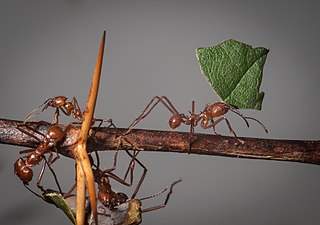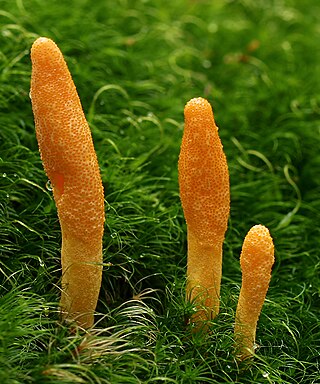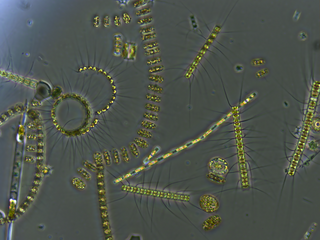Related Research Articles

Leafcutter ants are fungus-growing ants that share the behaviour of cutting leaves which they carry back to their nests to farm fungus. Next to humans, leafcutter ants form some of the largest and most complex animal societies on Earth. In a few years, the central mound of their underground nests can grow to more than 30 m (98 ft) across, with smaller radiating mounds extending out to a radius of 80 m (260 ft), taking up 30 to 600 m2 and converted into 3.55 m individuals.

The opisthokonts are a broad group of eukaryotes, including both the animal and fungus kingdoms. The opisthokonts, previously called the "Fungi/Metazoa group", are generally recognized as a clade. Opisthokonts together with Apusomonadida and Breviata comprise the larger clade Obazoa.

Cordyceps is a genus of ascomycete fungi that includes over 260 species worldwide, many of which are parasitic. Diverse variants of cordyceps have had more than 1,500 years of use in Chinese medicine. Most Cordyceps species are endoparasitoids, parasitic mainly on insects and other arthropods ; a few are parasitic on other fungi.

Landcare Research is a New Zealand Crown Research Institute whose focus of research is the environment, biodiversity, and sustainability.

The Ichthyosporea are a small group of Opisthokonta in Eukaryota, mostly parasites of fish and other animals.

The Laboulbeniomycetes are a unique group of fungi that are obligatorily associated with arthropods, either as external parasites or for dispersal (Pyxidiophorales).

A fungus is any member of the group of eukaryotic organisms that includes microorganisms such as yeasts and molds, as well as the more familiar mushrooms. These organisms are classified as one of the traditional eukaryotic kingdoms, along with Animalia, Plantae, and either Protista or Protozoa and Chromista.
Archaeobiology, the study of the biology of ancient times through archaeological materials, is a subspecialty of archaeology. It can be seen as a blanket term for paleobotany, animal osteology, zooarchaeology, microbiology, and many other sub-disciplines. Specifically, plant and animal remains are also called ecofacts. Sometimes these ecofacts can be left by humans and sometimes they can be naturally occurring. Archaeobiology tends to focus on more recent finds, so the difference between archaeobiology and palaeontology is mainly one of date: archaeobiologists typically work with more recent, non-fossilised material found at archaeological sites. Only very rarely are archaeobiological excavations performed at sites with no sign of human presence.

Kickxellomycotina is a fungus grouping. In the subkingdom of Zoopagomyceta Benny, 2007.

Ichthyophonida is an order of parasitic eukaryote, especially in the parasitizing of animals.

David Leslie Hawksworth is a British mycologist and lichenologist currently with a professorship in the Universidad Complutense de Madrid in Madrid, Spain and also a Scientific Associate of The Natural History Museum in London. Hawksworth has had a prolific career, authoring nearly 600 scientific works, describing approximately 250 new taxa, and proposing around 500 new combinations or new names in fungal nomenclature. In 1996, he was honoured as Commander of the British Empire (CBE). In 2002, he received the Acharius Medal from the International Association for Lichenology. Five genera and many species have been named in his honour.

Amoebidiidae is a family of single-celled eukaryotes, previously thought to be zygomycete fungi belonging to the class Trichomycetes, but molecular phylogenetic analyses place the family with the opisthokont group Mesomycetozoea. The family was originally called Amoebidiaceae, and considered the sole family of the fungal order Amoebidiales that included two genera: Amoebidium and Paramoebidium. However, Amoebidiidae is now monogeneric as it was recently emended to include only Amoebidium. Species of Amoebidium are considered obligate symbionts of freshwater-dwelling arthropod hosts such as midge larvae and water fleas (Daphnia). However, because Amoebidium species attach to the exoskeleton (exterior) of the host and grow in axenic culture, at least some species may be facultative symbionts.
Stachylinoides is a fungal genus in the Harpellaceae family. The genus is monotypic, containing the single species Stachylinoides arctata, found in the gut of insect larvae in South America.
Smittium is a genus of fungi in the order Harpellales. It is the largest genus in the order. As of 2013, there were 81 described species. Many of these have been formally described only recently; in 1998 there were just 46. Several have been transferred to Smittium from other genera, such as Orphella, Rubetella, Genistella, and Typhella. In general, the genus has a cosmopolitan distribution, but some species are limited to small regions.
Zoophthora is a genus of fungi in the family Entomophthoraceae. Like other taxa in this family, Zoophthora species cause disease in insects and as such are considered entomopathogenic fungi.

Mycoplankton are saprotrophic members of the plankton communities of marine and freshwater ecosystems. They are composed of filamentous free-living fungi and yeasts that are associated with planktonic particles or phytoplankton. Similar to bacterioplankton, these aquatic fungi play a significant role in heterotrophicmineralization and nutrient cycling. Mycoplankton can be up to 20 mm in diameter and over 50 mm in length.
Robert W. Lichtwardt was a Brazilian-born American mycologist specializing in the study of arthropod-associated, gut-dwelling fungi (trichomycetes). He is known for his online monograph and interactive keys to trichomycete taxa.

Amoebidium is a genus of unicellular, symbiotic eukaryotes in the Opisthokont group Mesomycetozoea, family Amoebidiidae. Amoebidium species attach to the exoskeleton of freshwater aquatic arthropods such as midge larvae and water fleas (Daphnia). The type species is Amoebidium parasiticum, which is also one of the only species to be cultured axenically.

Paramoebidium is a genus of unicellular, symbiotic eukaryotes that inhabit the digestive tract of immature freshwater arthropod hosts. Paramoebidium is classified in the opisthokont class Mesomycetozoea, and is the sole genus in the family Paramoebidiidae. Prior to 2005, Paramoebidium species were tentatively placed with the fungal group Trichomycetes due to their habitation of arthropod guts, host overlap between various Paramoebidium and fungal trichomycete taxa, and similar vegetative growth form.

Paramoebidiidae is a family of single-celled eukaryotes, previously thought to be zygomycete fungi belonging to the class Trichomycetes, but molecular phylogenetic analyses place the family with the opisthokont group Mesomycetozoea. The family was originally called Amoebidiaceae, and considered the sole family of the fungal order Amoebidiales that included two genera, Amoebidium and Paramoebidium. However, Paramoebidium is now the sole genus of the family Paramoebidiidae and Amoebidiidae is likewise monogeneric as it was recently emended to include only Amoebidium. Species of Paramoebidium are obligate symbionts of immature freshwater-dwelling arthropod hosts such as mayfly and stonefly nymphs and black fly larvae. Paramoebidium species attach to the digestive tract lining of their host via a secreted holdfast.
References
- ↑ Lichtwardt, R.W. (2012). The Trichomycetes: Fungal Associates of Arthropods. Springer Verlag.
- ↑ Lichtwardt, Bob (5 January 2016). "Trichomycetes key". keys. Dr. Lichtwardt. Retrieved 5 January 2016.
- ↑ "Record Details: Trichomycetes Alexop". Index Fungorum. CAB International. Retrieved 2016-02-07.
- ↑ Gareth Jones EB, Hyde KD, Pang KL (2014). Freshwater Fungi and Fungal-like Organisms. De Gruyter. p. 429. ISBN 978-3-11-039014-8.